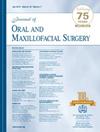Chondroid Diffuse Tenosynovial Giant Cell Tumor of the Temporomandibular Joint: A Case of a Rare Maxillofacial Tumor With Unique Pathophysiology and Therapeutic Considerations
IF 2.6
3区 医学
Q2 DENTISTRY, ORAL SURGERY & MEDICINE
引用次数: 0
Abstract
Diffuse tenosynovial giant cell tumors (D-TGCT) represent a rare group of benign proliferative lesions originating from the synovium of joints, bursae, and tendon sheaths, with infrequent involvement of the temporomandibular joint (TMJ). Among these, chondroid D-TGCT, previously known as pigmented villonodular synovitis with chondroid metaplasia, constitutes an even rarer subtype displaying a specific affinity for the TMJ. Despite its distinctive nature, only a limited number of cases (n = 30) of chondroid D-TGCT have been extensively documented in existing literature. This case report highlights an unusual instance of chondroid variant of D-TGCT within the TMJ and introduces novel adjuvant therapeutic techniques to prevent recurrence. Given the absence of definitive treatment protocols, our objective is to review existing literature on predictive markers for D-TGCT, aiming to facilitate timely diagnosis via core biopsy technique, and explore potential adjunctive therapeutic modalities that could complement surgical resection, especially in managing these locally aggressive tumor variants.
颞下颌关节软骨样弥漫性腱鞘巨细胞瘤:一例罕见的颌面部肿瘤,具有独特的病理生理和治疗考虑。
弥漫性腱鞘巨细胞瘤(D-TGCT)是一类罕见的良性增生性病变,起源于关节滑膜、滑囊和肌腱鞘,很少累及颞下颌关节(TMJ)。其中,软骨样D-TGCT,以前被称为色素绒毛结节性滑膜炎伴软骨样化生,是一种更罕见的亚型,对TMJ具有特异性亲和力。尽管其具有独特的性质,但在现有文献中,只有有限数量的D-TGCT病例(n = 30)被广泛记录。本病例报告强调了TMJ内D-TGCT软骨样变的一个不寻常的例子,并介绍了新的辅助治疗技术来预防复发。鉴于缺乏明确的治疗方案,我们的目标是回顾关于D-TGCT预测标志物的现有文献,旨在通过核心活检技术促进及时诊断,并探索潜在的辅助治疗方式,可以补充手术切除,特别是在管理这些局部侵袭性肿瘤变异方面。
本文章由计算机程序翻译,如有差异,请以英文原文为准。
求助全文
约1分钟内获得全文
求助全文
来源期刊

Journal of Oral and Maxillofacial Surgery
医学-牙科与口腔外科
CiteScore
4.00
自引率
5.30%
发文量
0
审稿时长
41 days
期刊介绍:
This monthly journal offers comprehensive coverage of new techniques, important developments and innovative ideas in oral and maxillofacial surgery. Practice-applicable articles help develop the methods used to handle dentoalveolar surgery, facial injuries and deformities, TMJ disorders, oral cancer, jaw reconstruction, anesthesia and analgesia. The journal also includes specifics on new instruments and diagnostic equipment and modern therapeutic drugs and devices. Journal of Oral and Maxillofacial Surgery is recommended for first or priority subscription by the Dental Section of the Medical Library Association.
 求助内容:
求助内容: 应助结果提醒方式:
应助结果提醒方式:


